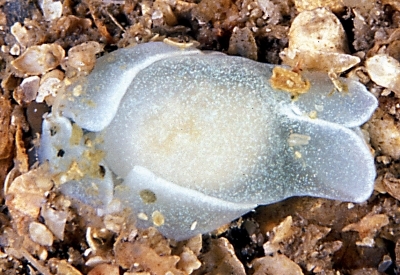
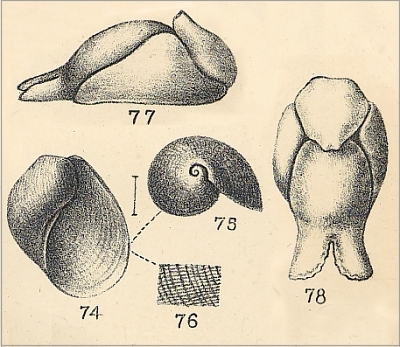
Philine pruinosa
(Clark, 1827)
Order: CEPHALASPIDEA
Superfamily: PHILINOIDEA
Family: Philinidae
DISTRIBUTION
Known from NE Atlantic from Norway to the Mediterranean
PHOTO
Upper: Living animal. Egersund, 25 metres, Norway, Norwegian Sea, 15. July 2006, Rocks and shell sand. Length: Less than 1 cm. Photographer: Erling Svensen.
Lower: Drawings of shell and living animal from Norway - from Sars, 1878 [Pilsbry, 1896: Pl.4 figs 74-78]
Little is known of the living animal but previous information summarised by Thompson (1976). From that we know that the posterior shield has a deep posterior sinus, and the parapodia are relativley small. Form Erling Svensen's photos it would seem the animal is translucent with fine white specks all over the body, and an opaque white border to the edge of the parapodia, the head shield and posterior shield. Some authors place this species in the genus Laona, but at this stage in our knowledge of the philinids there are not good grounds to try subdividing them into separate genera.
-
Pilsbry, H.A. (1896) Manual of Conchology; Structural and Systematic with Illustrations of the Species. [Ed: G.W.Tryon] Vol. 16, 251pp, Pls 1-71.
-
Rudman,W.B. (1972) The genus Philine (Opisthobranchia, Gastropoda). Proceedings of the Malacological Society of London, 40(3): 171-87, 10 figs.
-
Sars, G.O. (1878) Bidrag til Kundskaben om Norges Arktiske Fauna 1. Mollusca Regionis Articae Norvegiae. Universitetsprogram for foerste halvar 1878: 1-467, Tab I-XVI.
-
Thompson, T. E. (1976) Biology of opisthobranch molluscs. London, Ray Society no. 151. 1-207.
Rudman, W.B., 2007 (March 8) Philine pruinosa (Clark, 1827). [In] Sea Slug Forum. Australian Museum, Sydney. Available from http://www.seaslugforum.net/find/philprui
Related messages
Philine pruinosa from Nthn Ireland
March 12, 2007
From: Bernard Picton
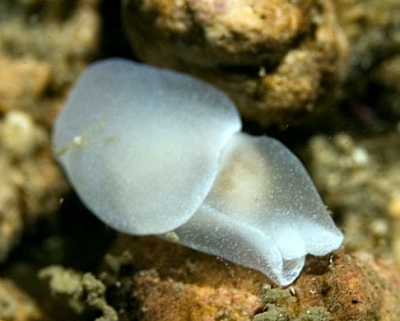
Concerning message #19088:
Hi Bill, Erling,
Yes, this is Philine pruinosa. The colour pattern with the white edges to the parapodia seems to be distinctive and characteristic and I identified my first one from shell characters and the radula. I've found it in Mulroy Bay on the north coast of Donegal on several occasions and last year Claire Goodwin photographed one on a maerl bed at Red Bay, Co Antrim, Northern Ireland. I'll attach that photo - rear end, so not as beautiful as Erling's. By the way, I can recommend the book by Erling and Frank Emil Moen, Marine fish and invertebrates of northern Europe. Originally it was published in Norwegian, but it is now available in English as well. http://www.marinbi.com/eng/index.htm
It has great photographs of Norwegian marine life, much of which we share here in Britain and Ireland.
Locality: Red Bay, Co Antrim, 20m, N. Ireland, UK, Atlantic Ocean, 16 June 2006, Maerl bed (calcareous seaweed). Length: 8 mm. Photographer: Claire Goodwin.
Bernard Picton
bernard.picton@magni.org.uk
Picton, B. E., 2007 (Mar 12) Philine pruinosa from Nthn Ireland. [Message in] Sea Slug Forum. Australian Museum, Sydney. Available from http://www.seaslugforum.net/find/19634Thanks Bernard,
Bill Rudman
Philine pruinosa from Norway
March 9, 2007
From: Erling Svensen
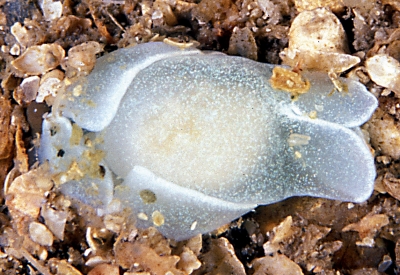

I sometimes see this unknown species in Egersund, South West Norway. Do you know what it could be?
Locality: Egersund, 25 metres, Norway, Norwegian Sea, 15. July 2006, Rocks and shell sand. Length: Less than 1 cm. Photographer: Erling Svensen.
Thanks for your help.
Erling Svensen
erling@egersund.com
Svensen, E., 2007 (Mar 9) Philine pruinosa from Norway. [Message in] Sea Slug Forum. Australian Museum, Sydney. Available from http://www.seaslugforum.net/find/19088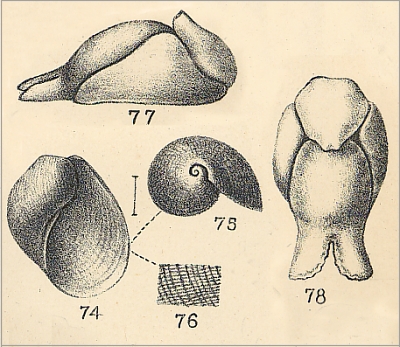
Dear Erling Svensen,
When I saw your upper photo it reminded me of a drawing I had seen of a Philine with a prominent split in the posterior shield, but it took me a while to find it. It was a drawing by Sars (1878) of an animal from Norway which he identified as Philine pruinosa. Pilsbry (1896) copied Sars's drawing which I reproduce alongside. We can see in the drawing that the parapodia also has relatively small parapodia and a border around the edge of the posterior shield. I can't recall seeing a photo of this before.
One problem with identifying most cephalaspidean bubble shells is that the species were described from the shape of the shell with no information on the living animal. The shell drawn here by Sars looks quite like Clark's shell but from looking at the literature, we know very little about this species. It certainly fits the animal from Norway that Sars called P. pruinosa so I think we will stick with that until specimens from England are better described.
-
Pilsbry, H.A. (1896) Manual of Conchology; Structural and Systematic with Illustrations of the Species. [Ed: G.W.Tryon] Vol. 16, 251pp, Pls 1-71.
-
Sars, G.O. (1878) Bidrag til Kundskaben om Norges Arktiske Fauna 1. Mollusca Regionis Articae Norvegiae. Universitetsprogram for foerste halvar 1878: 1-467, Tab I-XVI.
Best wishes,
Bill Rudman
